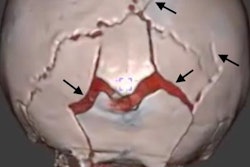
A new clinical decision-making tool may decrease the number of unnecessary CT exams for kids presenting with blunt head trauma by approximately 34%, according to an article to be published in the July issue of Academic Emergency Medicine.
The use of clinical decision tools to assess the need for head CT has become more common in recent years, noted lead author Dr. Malkeet Gupta and colleagues from the University of California, Los Angeles (UCLA). The most widely used tool, the Pediatric Emergency Care Applied Research Network (PECARN) rule, has demonstrated accuracy matching that of physician judgment.
However, a validation study by Babl et al found that the exclusive use of such decision tools would increase the number of unnecessary emergency head CT exams -- by as much as 39.5% in the case of PECARN.
To limit excess imaging, Gupta and colleagues designed a method to effectively rule out CT for kids presenting with blunt head trauma by coupling physician judgment with a protocol they developed: the National Emergency X-Radiography Utilization Study (NEXUS) head CT decision instrument.
The technique recommends that clinicians first exclude any patients at low risk of having a clinically significant head injury on the basis of clinical judgment. Clinicians should then apply the decision tool only to the remaining intermediate- and high-risk patients. Ideally, this approach would help them identify all cases requiring CT scans without unnecessarily increasing the number of exams performed, according to the group.
Pediatric patients who lack one or more of the following criteria should be viewed as being at high risk of a clinically significant head injury and referred for a CT exam:
- No evidence of skull fracture
- No scalp hematoma
- No neurologic deficits
- Normal level of alertness
- Normal behavior
- No persistent vomiting
- No coagulopathy, or impairment of normal blood clotting
Using their strategy of combining physician judgment and a clinical decision tool, the researchers evaluated CT utilization in 1,018 emergency pediatric cases involving blunt head trauma. Together, physician judgment and the NEXUS head CT decision instrument led to the identification of all 27 cases requiring neurosurgical intervention and 48 of the 49 patients who ended up with significant head injuries on CT.
| Accuracy of NEXUS head CT decision instrument for kids with blunt trauma | ||
| Clinically significant head injury on CT | Need for surgical intervention | |
| Sensitivity | 98% | 100% |
| Specificity | 34% | 33% |
| Negative predictive value | 99.7% | 100% |
"This 'judgment first, decision instrument second' approach may decrease head CT utilization in low-risk pediatric populations by up to 34%," Gupta and colleagues wrote. "Under this model, [decision instruments] can be coupled with clinical judgment to provide better outcomes than either approach alone."



















